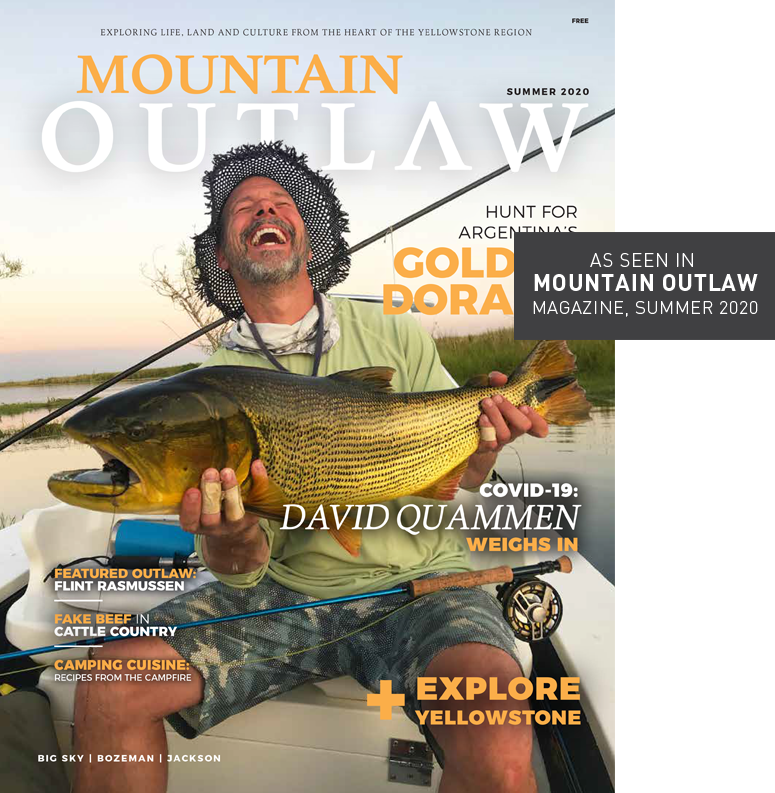“It was the Wild West, but in a good way. It was fun, uncorked.”
BY DARIA UPORSKY
I remember standing outside Kellem’s Saddle Shop in Gardiner, Mon- tana, shoulder-to-shoulder with Carol Kellem as we watched them pave over the dirt parking lot. Until that summer of 2016, the dusty roads and obscure store fronts were more of a pit stop than a destination for visitors on their way to Yellowstone National Park.
It felt like paving over the dirt would also efface the beloved, gritty culture of the town. With a distant look in her eyes, Carol said she wasn’t so sure she belonged here anymore.
A few years later, I sat in the back of the shop with Carol, surrounded by tables of leather-working tools and piles of scraps. Carol had not left Gardiner but every year she planned on it. Perhaps she held onto a previous version of her home. That day, I listened to her describe what used to make this little gateway town so special.
“It was the Wild West, but in a good way. It was fun, uncorked.” Carol smiled. Light brown waves of hair framed her gentle face and a silk scarf splayed out loosely from the top of her blouse.
“It could be the middle of the day, but you would still stop before walking past the saloon door.” A safety measure, she explained. “You had to carefully peer inside the Two Bit before walking by to make sure no one was gonna fly out of it!” Carol giggled, recalling the rowdy locals who at any moment might take a brawl into the streets.
“And ‘Space Mike’—that’s what we called him—would shoot out the street lights at night. They’d put a new one in and he’d shoot it out … There were the old timers …” She paused. “They’ve all passed on.
“There were the horn hunters, too, who were looking to get elk antlers from the park.” Carol looked over at me. “That’s illegal, you know. And, there were the transients. They weren’t dangerous, they just didn’t fit in. I was part of that group.”
Carol and her husband Les came to Gardiner 35 years ago by fate. Without a particular destination in mind, they packed up their newborn daughter, some horses and what few belongings they owned, and drove west from South Dakota. Perhaps it was the unique mix of folks in the little town. Maybe it was the mountains that hug Gardiner, lending it detachment from the rest of the world. Either way, newcomers often sense that they done stumbled across a lost world. And Les and Carol felt right at home.
But it’s all changed since then. I asked Carol how she would describe Gardiner these days.
“It’s just,” she said at last, “It’s just a place.” We fell into a moment of silence as if to pay our respects to a loved one who passed. I ask her if tourism is at fault.
Carol thought about it. “In a way, I suppose so. I never thought of it like that before, but that is why people are staying—just to get a piece of the pie. It used to be you had to be a little crazy to move here. Now I’m just amazed tourists go up Tom Miner to watch the bears. Those little dirt roads are not meant to be traveled that heavily.”
Tom Miner Basin, just north of Gardiner, was discovered a few years back as a prime spot for viewing grizzly bears. It had previously been a quiet patchwork of ranches and wilderness. Now there are hoards of cars and tour buses mobbing it from May through October. I went up there one late summer day in 2018, shortly after I learned the area had become a tourist attraction. The crowd was bigger than I imagined. I stayed in my car and watched as ranchers passed by, their faces hardening as they approached. Then they would stomp the gas pedal, spinning the tires and sending dust clouds billowing as they drove out of sight.
I asked if the store had felt the economic impact. “I suppose so. I make money, but in a different way,” Carol said. “We used to serve the needs of locals more than the tourism crowd.”
Callie Kellem, the younger of Carol’s two daughters, was quietly listening while she tooled a scrap of leather. “This is a two-fold answer,” Callie offered. “There is more money to be made now, but the people who want to live here and support the local economy year round cannot afford to do it.”
What would this mean if, given the current public health concerns, tourism crowds in Gardiner diminish into the fall and beyond?
A short time later, I sat in my truck outside the Kellems’ shop. I looked down the street at dusty cowboy hats and lassos hanging from store fronts, mimicking an authenticity of yesteryear. Gardiner is no longer just a gateway to adventure in the park, it’s become a destination itself. But the wild landscape, the thing that keeps people like Carol here, is at risk.
Turning the steering wheel, I watched the elk dutifully gnaw away the native plants installed around the paved lot. This was not part of the plan, I mused.
Daria Uporsky is a professional writer and amateur nature photographer based in the foothills of Western North Carolina. She has been traveling to Montana for over a decade, and now considers it her “home away from home.”

